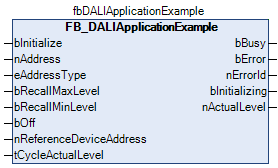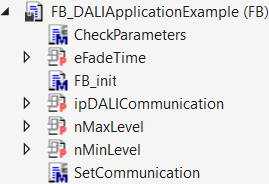Creating an application function block
The following section illustrates how to create an application function block based on the Tc3_DALI library. The example describes a simple function block that controls control gears via short address, group address or broadcast.
Here you can find the TwinCAT project with the sample.
 | The TwinCAT project is available for download as *.zip file. This must first be unpacked locally so that the archive (*.tnzip file) is available for import into the TwinCAT project. |

A positive edge at one of the three inputs sends the DALI command RECALL MAX LEVEL, RECALL MIN LEVEL or OFF.
Parameterization of the DALI control gears
The function block can initialize the variables maxLevel, minLevel and fadeTime of DALI control gears. Corresponding properties are available for this purpose. Their values are written to the DALI control gears when a positive edge is detected at bInitialize. During this time the output bInitializing is TRUE.

DALI short address for reference device (nReferenceDeviceAddress)
The parameter nReferenceDeviceAddress is used for reading the output value of a reference DALI control gear cyclically in the background (tCycleActualLevel > 0 s). The output value is available at the output nActualLevel.
No reference DALI control gear is required if a single DALI control gear is to be controlled with the function block (eAddressType = E_DALIAddressType.Short). In this case, the output value of the individual control gear is determined via the individual address nAddress.
If a DALI group is addressed with the function block (eAddressType = E_DALIAddressType.Group), nReferenceDeviceAddress must always contain the short address of a DALI control gear, which must be located in the addressed DALI group.
Even with a broadcast (eAddressType = E_DALIAddressType.Broadcast), a DALI control gear with a corresponding short address must be located on the DALI line.
Transfer of the reference to the communication block
When declaring the function block, the complete path of the communication block (FB_KL6811Communication, FB_KL6821Communication or FB_EL6821Communication,…) is specified in round brackets.
fbDALIApplicationExample : FB_DALIApplicationExample(Communication.fbKL6821Communication);This is used to specify via which DALI terminal the function block is to communicate.
In FB_DALIApplicationExample the parameter is passed by the method FB_init. The method FB_init is called automatically by the TwinCAT 3 runtime environment, once before the PLC program is started.
The parameter is of type I_DALICommunication and is contained in the Tc3_DALI library. All communication blocks (FB_KL6811Communication, FB_KL6821Communication or FB_EL6821Communication, …) have implemented this interface. All DALI command function blocks (e.g. FB_DALI102Off) communicate with the DALI communication block via the interface pointer.
In the method FB_init the parameter is assigned to the variable _ipDALICommunication of the function block.
To ensure that the reference can be changed at runtime, the interface pointer is also passed to the device function block via the property ipDALICommunication. Internally, the property is stored in the variable _ipDALICommunication.
In the device function block it must be ensured that this interface pointer is passed on to all DALI command function blocks. The internal method SetCommunication is available for this purpose. In this method the interface pointer is passed to all DALI command function blocks located in the function block. The property ipDALICommunication is used in the command function blocks for this purpose. This property is used to reassign the reference to the DALI communication block at runtime.
Checking the parameters
All parameters are checked by the internal method CheckParameters. In the event of an error the method returns the error Id, or 0 if there is no error. The Ids of the runtime messages can be used here:
IF (THIS^.ipDALICommunication = 0) THEN
CheckParameters := TC_EVENTS.TcDALIEventClass.TheInterfaceToTheCommunicationBufferIsNotInitialized.nEventId;
END_IFIf required, you can also use your own error Ids, starting at 1000:
IF (<check your parameter>) THEN
CheckParameters := 1000;
END_IFSimilar to SetCommunication, CheckParameters is also called in the first PLC cycle. This call also occurs if a positive edge was detected at the inputs bInitialize, bRecallMaxLevel, bRecallMinLevel or bOff.
Alternatively, you could call the method every time the value of a parameter has changed.
Structure of the function block
In the upper part of the function block the positive edges of the inputs bInitialize, bRecallMaxLevel, bRecallMinLevel or bOff are queried.
The middle part contains a step sequence in which the individual actions are carried out. If a positive edge is detected at one of the inputs, the corresponding step of the step sequence is triggered. The DALI command QUERY ACTUAL LEVEL is sent once the DALI commands RECALL MAX LEVEL (step 200) or RECALL MIN LEVEL (step 300) have been executed. This reads the new output value from the DALI reference device and outputs it at the output nActualLevel. The variables maxLevel, minLevel and fadeTime are written from step 10000.
In the lower part, the output value is read cyclically from the DALI reference device and output at the output nActualLevel.
Comments
The step sequence can only be set to a new action if no action is currently being executed (nStep = 0).
The number of DALI commands should be minimized. For example, after the DALI commands RECALL MAX LEVEL or RECALL MIN LEVEL, the current output value is only read out if during the next 1000 ms the output value is not already read out by cyclic querying in the lower part of the function block:
IF (((tonCycleActualLevel.PT - tonCycleActualLevel.ET) > T#1S) OR (tCycleActualLevel = T#0S)) THEN
nStep := 9000;
ELSE
bBusy := FALSE;
nStep := 0;
END_IF